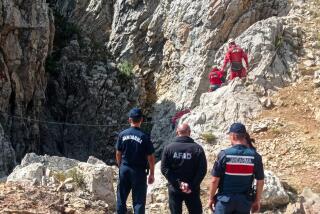Turks Act to Save Ancient Cave Dwellings
- Share via
NEVSEHIR, Turkey — Erosion and unbridled tourism are blamed for damaging the ancient labyrinthine dwellings of Cappadocia, a jewel in Turkey’s archeological crown.
United Nations’ agencies say firm action is needed to save cave dwellings, including several hundred Christian churches with priceless Byzantine frescoes.
Cappadocia, on a former trading crossroad between Asia and Europe once inhabited by Hittites, became a center of Christian monasticism 1,500 years ago and later a fertile area for the development of Islamic science and arts.
“Environmental degradation is causing irreparable damage to these cultural properties, with the potential of their complete loss and the loss of tourism revenue,” said Ankara-based Edmund Cain of the U.N. Development Program.
“It is a unique site. It captures the very essence of our culture, if not of our civilization,” he said during a workshop in the Cappadocian city of Nevsehir, 175 miles southeast of Ankara, on preserving the region.
Preservation problems are immense for an area covering 2,184 square miles, which has become a mainstay of Turkey’s drive for more tourism revenue to help its troubled economy.
The area is dotted with toadstool-like “fairy chimneys”--grotesque columns formed by mud and volcanic ash and topped by chunks of basalt.
It also boasts two major troglodyte underground complexes excavated to a depth of 10 stories and believed to date back to pre-Christian times. They were used as places of refuge as recently as 1839 to escape marauding armies.
The main concern for preservationists is Goreme, among 38 sites on the World Heritage List of the United Nations Educational, Scientific and Cultural Organization.
Several thousand tourists flock daily to Goreme, where rockfalls and erosion are eating away caves, and graffiti and centuries of vandalism have damaged unprotected frescoes.
“It is a fabulous site. It is as if you are on another planet,” Abdel-Khader Errahmami, head of cultural heritage protection at UNESCO, said.
“A master plan for preservation is an absolute necessity. There should be a single body to speak for the region, possibly incorporating government, the private sector, different associations and local inhabitants,” he said.
Overall control of the area is handled by three ministries in Ankara--tourism, culture and public works and housing. This poses major coordination problems.
“We don’t need people to come in a helicopter from Ankara, look at the area from a minaret and make a plan. It must be done by people who understand,” said Raci Bademli of the faculty of architecture at Turkey’s Middle East Technical University.
Cevat Erder, head of conservation of cultural heritage at the university, said: “Goreme has been exposed to large-scale tourism recently. We are trying to control a chaotic situation and keep its natural and historic beauty.”
More to Read
Sign up for Essential California
The most important California stories and recommendations in your inbox every morning.
You may occasionally receive promotional content from the Los Angeles Times.













